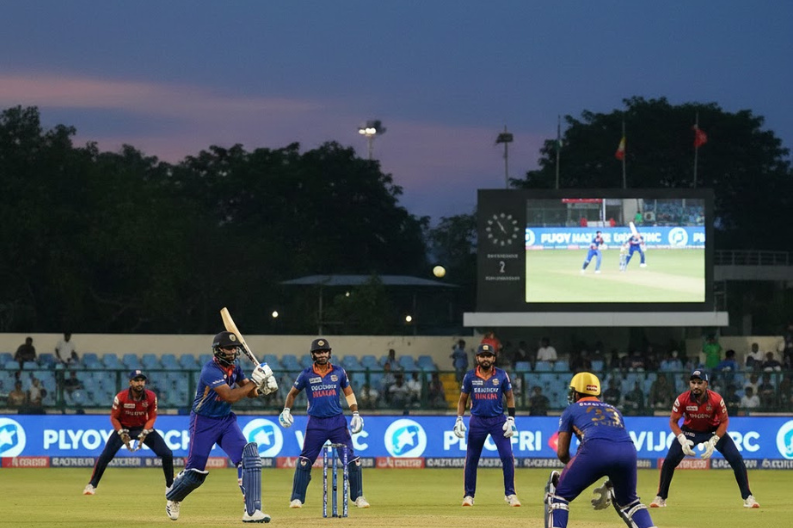Daily News
Traffic Chaos at Mohali and Zirakpur as Barricades Block Entry to Chandigarh
Recently, the police in Chandigarh have put up barricades at the Chandigarh-Mohali border.

A sudden Traffic Chaos at Mohali and Zirakpur has left thousands of commuters frustrated as police set up barricades at the Chandigarh-Mohali border near Phase-6, Mohali. The police are blocking entry from Mohali into Chandigarh, causing long queues and severe inconvenience for daily travelers. Drivers, passengers, and even public transport users are struggling to move through the area.
Police officers are stationed at the barricades to control traffic. They have parked large trucks and buses across the road to strengthen the blockade. As a result, vehicles are lining up for long distances, and traffic is crawling through narrow routes. Many drivers spent over an hour in traffic, and tempers ran high among commuters.
People living and working in Mohali are facing major delays. Some have tried to use smaller roads, but these routes are now overcrowded too. Traffic movement has become unpredictable, and congestion has spread to nearby areas like Phase-5 and Phase-7. Daily commuters say the situation is worse during office hours when hundreds of vehicles attempt to cross the border at once.
The problem is not limited to Mohali alone. The Chandigarh-Zirakpur border has also turned into a traffic nightmare. Police are checking every vehicle entering Chandigarh, which slows the process even further. Long lines of cars, trucks, and two-wheelers now stretch for several kilometers. Many drivers are trying to take shortcuts through residential colonies, but these detours only make the situation worse, adding to the traffic jams in Zirakpur.
According to local residents, these restrictions started after increased security checks in the region. The police have not officially announced how long the barricades will remain, which has left commuters confused and upset. Regular travelers say they now have to leave home at least an hour earlier to reach their destinations on time.
Mohali, known for its wide roads and clean environment, has seen growing traffic problems in recent years. It was once ranked as the third-best urban area in India after Chandigarh and Pune. Around 50,000 vehicles cross from Mohali into Chandigarh daily, making this border a crucial route for workers, students, and business owners. However, with urban growth and more private vehicles on the road, congestion has increased by nearly 20% over the past few years.
Traffic jams like this affect more than just vehicles. Students often reach schools late, and office workers lose valuable time. In emergency cases, ambulances and patients face life-threatening delays. Public transport, including buses and auto-rickshaws, also struggles to stay on schedule, leaving passengers stranded.
Experts suggest that the administration must take quick action. Improving public transport with more buses and better timing could reduce car usage. Authorities should also use smart traffic systems to monitor congestion in real time and adjust signals accordingly. Setting up alternative routes for heavy vehicles could help ease pressure on busy roads.
In addition, spreading awareness among citizens is crucial. Regular traffic updates through mobile alerts or radio broadcasts can help people plan better and avoid rush hours. Local shopkeepers and residents can also cooperate by keeping entry lanes clear for moving traffic.
If authorities coordinate with residents and technology, traffic can flow more efficiently. Until then, drivers continue to face long waits and growing frustration at the barricades. This ongoing Traffic Chaos at Mohali and Zirakpur shows how urgent it is to plan smarter roads and manage urban traffic before it brings daily life to a complete stop.
Daily News
Vijay Hazare Trophy Live: Star Players Return as India’s Premier 50-Over Tournament Begins

The Vijay Hazare Trophy live matches kick off on Wednesday, December 24, bringing India’s top domestic 50-over cricket tournament back into focus. Moreover, this season carries extra excitement as several big names make their return to the competition.
Virat Kohli steps onto the Vijay Hazare stage for the first time in nearly 16 years. Similarly, Rohit Sharma returns after almost eight years away from the tournament. Both veterans recently showed excellent form against South Africa, consequently proving they remain crucial for India’s 2027 World Cup plans.
However, fans won’t get to watch matches at the M Chinnaswamy Stadium in Bengaluru. Instead, organizers moved games to BCCI’s Centre of Excellence to prevent overcrowding after the recent stampede during RCB’s IPL celebration.
Key Players to Watch
Several Mumbai Indians stars will compete across different state teams:
| Player | State Team | Current Form |
|---|---|---|
| Rohit Sharma | Mumbai | Two recent half-centuries vs South Africa |
| Suryakumar Yadav | Mumbai | Needs runs badly (avg 12.84 in T20Is) |
| Hardik Pandya | Baroda | 77* in recent SMAT match |
| Shardul Thakur | Mumbai | Explosive 73 off 28 balls vs Nagaland |
| Robin Minz | Jharkhand | 166 runs in SMAT |
Furthermore, Suryakumar Yadav desperately needs this tournament. His T20I form has collapsed over the past year with no half-centuries in 22 innings. Therefore, these matches give him a perfect chance to regain confidence before the New Zealand series on January 21.
Rishabh Pant, meanwhile, will play all seven group matches for Delhi. This extended run offers him an opportunity to force his way back into India’s limited-overs plans.
Tournament Format and Opportunities
The competition has proven extremely competitive recently. Indeed, five different teams have won the last five seasons. Karnataka, the defending champions, welcome back Karun Nair, who smashed an incredible 779 runs last season at an average of 389.5.
Additionally, strong performances here often lead to bigger opportunities. Last year, Arshdeep Singh and Varun Chakravarthy’s excellent bowling earned them national team recalls and eventually Champions Trophy spots.
All matches start at 9am to reduce dew impact. Consequently, winning the toss becomes crucial as fast bowlers will find helpful morning conditions.
Young talents like R Smaran and experienced players seeking IPL contracts will view this as their audition stage. Teams play across four venues: Bengaluru, Jaipur, Ahmedabad, and Ranchi.
As the Vijay Hazare trophy live action unfolds over the coming weeks, cricket fans can expect thrilling contests, career-defining performances, and perhaps the emergence of India’s next big stars. The tournament runs until mid-January, giving players ample time to stake their claims for higher honors.
Daily News
Income Tax Refund Risk Management: CBDT Warns Taxpayers to Review Invalid Claims Before December 31 Deadline

The Central Board of Direct Taxes (CBDT) has launched an income tax refund risk management initiative, urging taxpayers to voluntarily check their tax returns for incorrect claims. Moreover, the department identified numerous cases where people claimed deductions or exemptions they weren’t entitled to receive.
Through its “NUDGE” campaign (Non-intrusive Usage of Data to Guide and Enable), the tax department sends SMS and email alerts to affected taxpayers. Consequently, this allows them to correct mistakes before facing formal inquiries.
What Did the Tax Department Find?
Using advanced data analytics, CBDT discovered several problematic patterns in Assessment Year 2025-26 returns:
| Issue Type | Description |
|---|---|
| Bogus Donations | Fake donations claimed to Registered Unrecognised Political Parties (RUPPs) |
| Wrong PANs | Incorrect or invalid Permanent Account Numbers of recipients |
| Ineligible Exemptions | Claims for deductions taxpayers don’t qualify for |
| Incorrect Amounts | Wrong calculation of deduction or exemption amounts |
Furthermore, these errors led to understatement of income and wrongful refund claims.
Important Deadline and Actions
Taxpayers identified under this campaign must act quickly. Specifically, they need to file revised income tax returns by December 31, 2025. However, those who miss this deadline can still submit updated returns from January 1, 2026, though they’ll need to pay additional tax liability.
Additionally, the CBDT clarified an important point: taxpayers whose claims are genuine and legally correct don’t need to take any action. Therefore, only those with questionable claims should worry about this campaign.
Why This Campaign Matters Now
The timing of this initiative appears significant. Indeed, income tax refunds have dropped notably this year. Between April 1 and December 17, 2025, the department issued refunds totaling ₹2.97 lakh crore-a 13.52% decline compared to last year’s same period.
Meanwhile, the campaign has already shown positive results. Over 2.1 million taxpayers voluntarily updated their returns for previous years (2021-22 to 2024-25) during FY 2025-26, paying more than ₹2,500 crore in additional taxes. Similarly, another 1.5 million taxpayers revised their current assessment year returns.
How to Respond to the Notice
If you receive an SMS or email from the Income Tax department:
- Review your ITR carefully – Check all deduction and exemption claims
- Verify donation receipts – Ensure PANs and amounts match records
- Calculate correctly – Confirm you qualify for claimed benefits
- File revised return – Submit corrections before December 31, 2025
- Keep documentation – Maintain proof of legitimate claims
Subsequently, this proactive approach helps avoid penalties and formal assessments later.
The income tax refund risk management framework represents the department’s shift toward technology-driven compliance. Rather than launching aggressive investigations, authorities now encourage voluntary corrections through data-based nudges. Ultimately, this approach benefits both taxpayers and the government by reducing disputes while improving tax collection efficiency.
Daily News
Yuvraj Singh: Viral Bat Auction Claim Debunked; ED Attaches Assets in Betting Case

Former Indian cricket star Yuvraj Singh finds himself in the news for two completely different reasons. Moreover, one story involves a misleading viral claim, while the other concerns a serious legal matter with the Enforcement Directorate.
The Bat Auction Claim: What’s True and What’s False
A viral social media post claims that Lalit Modi auctioned Yuvraj Singh’s bat-the one used to hit six sixes in an over during the 2007 T20 World Cup-for ₹7 crore. However, this claim is misleading.
What Actually Happened:
| Fact | Details |
|---|---|
| The Promise | Lalit Modi offered a Porsche to anyone hitting six sixes in an over |
| The Achievement | Yuvraj Singh accomplished this against England in 2007 |
| The Gift | Modi gave Yuvraj a Porsche worth ₹91 lakh |
| The Exchange | Modi asked for the bat in return |
| Current Status | The bat remains with Modi at his London home |
Furthermore, Modi confirmed in two recent podcasts-one with Raj Shamani (November 2024) and another with Stuart Clarke (August 2025)-that he still possesses the bat. Specifically, he mentioned that when Yuvraj asked for the Porsche, Modi requested the historic bat in exchange.
Additionally, no credible auction house or media organization has reported any such auction. Indeed, if a bat sold for ₹7 crore, it would have generated massive media coverage, especially since Shane Warne’s iconic cap sold for only ₹5.79 crore.
ED Takes Action: Assets Attached
Meanwhile, Yuvraj Singh faces a more serious situation. On December 19, 2025, the Enforcement Directorate (ED) provisionally attached assets worth ₹7.93 crore belonging to Yuvraj and several other celebrities.
Who Else Is Involved?
The ED action includes:
- Former cricketer Robin Uthappa
- Actors Sonu Sood, Neha Sharma, Ankush Hazra
- Model Urvashi Rautela and her mother
- Former MP Mimi Chakraborty
Why Did ED Take This Action?
The investigation centers on the illegal offshore betting platform 1xBet. Consequently, the ED alleges that these celebrities knowingly promoted the platform through surrogate brands like 1xBat and 1xBat Sporting Lines.
Specifically, the agency discovered that:
- Illegal Operations – 1xBet operated in India without authorization
- Hidden Payments – Money came through foreign entities to hide illegal origins
- Surrogate Marketing – The platform used fake brands to target Indian users
- Layered Transactions – Payments went through multiple foreign intermediaries
Previously, in October 2025, the ED also attached ₹11.14 crore worth of assets belonging to cricketers Shikhar Dhawan and Suresh Raina in the same case.
Important Warning
The ED cautioned celebrities and influencers against promoting illegal betting platforms. Similarly, they advised the public to avoid such platforms and report suspicious activities to law enforcement agencies.
Therefore, Yuvraj Singh now faces scrutiny over his alleged endorsement activities, while simultaneously dealing with false viral claims about his cricket memorabilia. These parallel situations highlight how celebrities must carefully manage both their public image and business associations in today’s digital age.
-

 City Guide3 years ago
City Guide3 years ago3B2 Mohali Market Shops: Discover 44 Hidden Gems
-

 Entertainment2 years ago
Entertainment2 years agoTop 15 Punjabi Models – Male and Female List
-

 Entertainment3 years ago
Entertainment3 years agoTop 11 Punjabi Comedians of All Time
-

 Jobs4 years ago
Jobs4 years agoTop 20 IT Companies in Mohali
-

 Food4 years ago
Food4 years ago11 Best Restaurants in Mohali You Must Visit
-

 Property2 years ago
Property2 years agoWho Lives In Homeland Mohali: Punjabi Celebrities, Business People…
-

 Food3 years ago
Food3 years agoTop 15 Cafes in Mohali you must visit
-

 Education2 years ago
Education2 years ago10 Famous Punjabi Writers With A Great Impact On The Literary World
